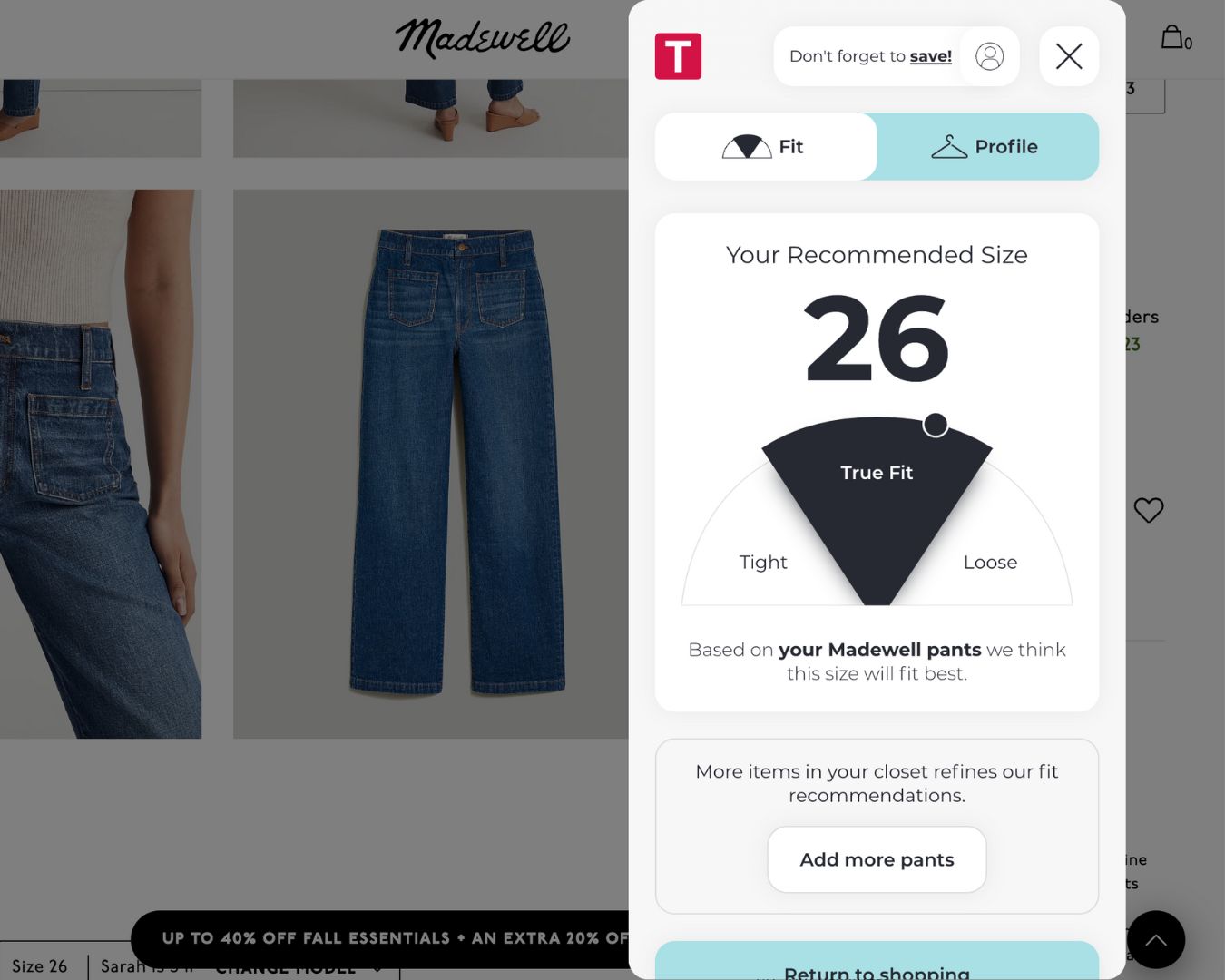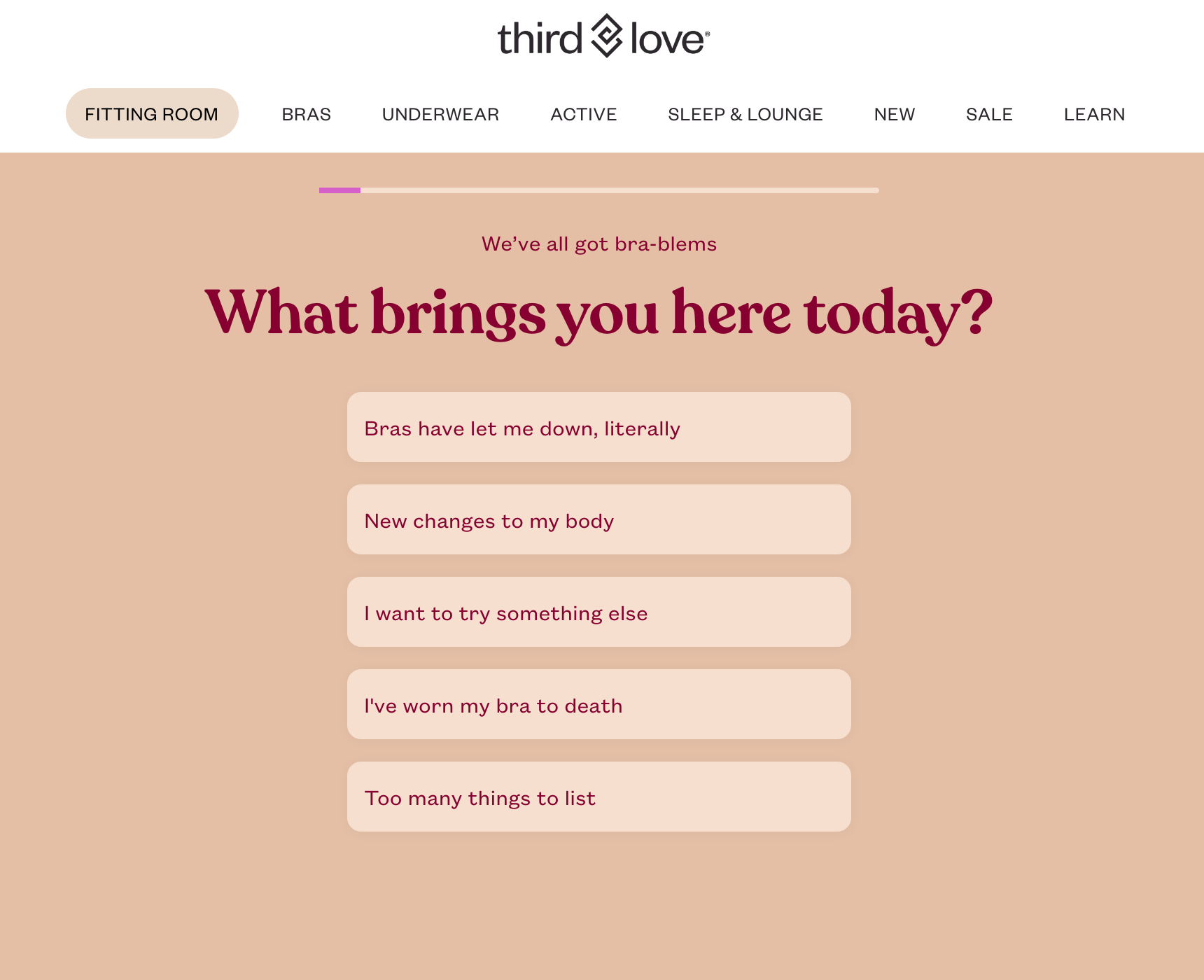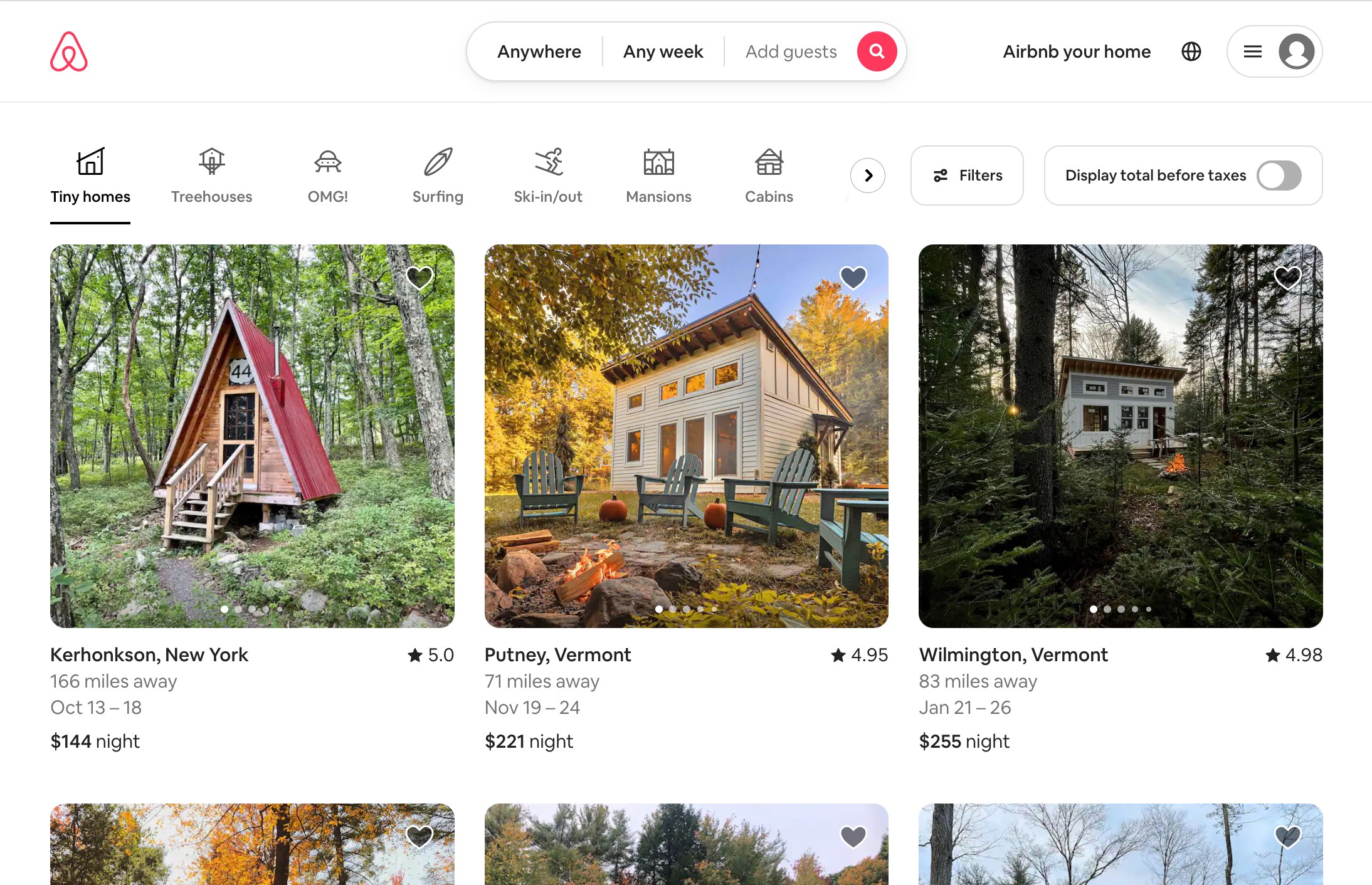Within the past five years, a renewed focus on personalization has emerged within e-commerce brands through guided shopping experiences.

Countless brands now offer chatbots, for instance, to help direct customers to products that fit their needs. Other innovative tools, like True Fit, have helped fashion brands offer customers personalized size recommendations.

Additionally, many e-commerce brands have built powerful, value-driven reputations by launching quiz platforms that create lists of personalized recommendations for customers based on their responses.

The personalized experience that ThirdLove’s Fitting Room® platform offers, for example, doesn’t just help customers find the bra that fits them best, it also underscores the brand’s core values of diversity and inclusivity.
Now, with powerful new AI and ML tools at brands’ disposal, it’s time to ask: what’s next in the personalization evolution?
Say hello to conversational commerce.
Personalization’s next big evolution
We believe the next big evolution in personalization for e-commerce is conversational commerce.
In many ways, conversational commerce is a natural progression of guided shopping, a trend that’s already proven its value in this arena. The basic idea is using tools like chatbots, voice assistants, and messaging apps—which are already on the cutting edge with AI capability—to engage with audiences in real time.
Where it gets really interesting is when you consider how conversational commerce fits into the customer journey against the backdrop of another trend: Discovery-based search.
Just like personalization, search is also evolving. When Gen Z needs to find information, like product reviews or a how-to guide, they go to TikTok.
“More and more young people are using TikTok’s powerful algorithm — which personalizes the videos shown to them based on their interactions with content — to find information uncannily catered to their tastes,” reported The New York Times.
Gen Z has developed a preference for information that’s tailored to their individual needs and delivered in a more organic, human way than what ye olde Google offers.
And it’s not just them either. Consumers of all ages browse through pages of content while on the hunt for more detailed information about a product before purchasing it—even searching for information on a product across multiple platforms, from asking Google for comparable options to searching YouTube for in-depth reviews.

Imagine delivering a tool to consumers that would enable them to access all of that information—in a way that’s personalized to them and their needs—directly on your brand’s e-commerce site.
It’d certainly help consumers cut down on their number of browser tabs. And it would create a deeper, more meaningful way for them to discover products.
Sounds pretty good, right? We’re only just scratching the surface. Let’s take a more in-depth look at the potential for conversational commerce.
B2C potential
From a B2C perspective, Forbes indicates that conversational commerce can provide a personalized “concierge-style” experience that’s more convenient and streamlined, helping brands reduce cart abandonment, boost online sales, and drive brand loyalty.
To give a sense of how that “concierge-style” experience manifests across different B2C industries, here are a few examples of brands where we see big potential for a conversational commerce strategy.
Fashion & beauty
We’ve already highlighted the ThirdLove Fitting Room®, a multiple-choice survey designed to provide personalized consumer recommendations, as an example of a guided shopping experience, an approach that’s trending across fashion & beauty.
Just like ThirdLove, other brands and their respective quiz platforms—including Honest Company’s Skin Shade Quiz and Curology’s Skin Quiz—could be transformed from a multiple-choice survey into an open-ended format through conversational commerce.
Most importantly, a conversational commerce-based approach would enable consumers to identify their specific needs instantly—without clicking through irrelevant questions—and educate them about which clothing sizes and cuts or skincare ingredients and formulas are best suited for them.
Other brands that opted for a different type of personalized customer experience, like Patagonia, can also benefit from conversational commerce.

The customer experience we helped Patagonia build was designed to help customers find the right gear for them while also engaging them through the power of storytelling. An intelligent chatbot could apply these same principles, providing a unique tone of voice that highlights a brand’s story and identity while guiding consumers toward the most accurate recommendations.
Travel
Within the travel industry, we’re seeing brands pivoting to focus on the popularity of Discovery-based search and a consumer journey that now spans multiple channels.
Take Airbnb for example, which now encourages users to browse and find the type of destination they’re looking for—with categories like “amazing views,” “cabins,” and “treehouses”—before filtering based on budget and number of guests.

Through conversational commerce, consumers could plan their trips much more effectively. Chatbots could supply them instantly with options for stays available within their timeline and a messaging app could even follow up with suggestions for better dates if a consumer books their beachside vacation on what weather reports predict will be a rainy weekend.
To summarize, here’s what conversational commerce brings to the B2C table:
- Smarter, savvier engagement. The ability to engage customers in an innovative way that streamlines their experience and drives them to complete a purchase.
- Instantaneous customer service. The ability to answer specific questions and troubleshoot instantly with an open-ended, 1:1 conversation.
- A multi-channel funnel. The ability to reduce the number of channels consumers go to before making a purchase by funnelling the information they’re looking for into a single source.
B2B potential
A quick Google search for “conversational commerce” is enough to show that the idea is gaining momentum as a new trend in the industry. That said, the discussion almost exclusively surrounds conversational commerce’s potential for B2C customers.
But conversational commerce’s application extends beyond personalizing the B2C customer journey—the streamlined, intelligent experience it offers makes conversational commerce a source of enormous potential value for B2B customers.
Example: Complex B2B ordering
Take a business like Capstone, a children’s publishing house, for example. We helped Capstone build a platform designed to supply public libraries and noticed firsthand how complex large B2B orders like this can be.
When libraries place an order with Capstone, they put a huge amount of effort into maximizing their budget. This is trickier than it sounds: these customers would have to find the right combination of books and periodicals that would come the closest to hitting their budget while also ensuring that they filled their shelves with bestsellers, titles their patrons had requested, the latest issues of magazines & newspapers, and so on.
By implementing conversational commerce, Capstone could offer libraries the advantage of a streamlined experience that would do this complicated work for them. A library could submit a list of titles for an order and their budget to a chatbot, which could then return suggestions for a better order—taking into consideration discounts, promotions, and recommendations based on customer reviews.
A conversational commerce platform would also offer Capstone customers the benefit of intelligent record-keeping, letting libraries know if a title had been included in a previous order and even crosschecking their catalog to make doubly sure no part of the order budget was being spent on duplicates.
To summarize, here’s what conversational commerce brings to the B2B table:
- Informed recommendations. The ability to improve the overall quality of an order by balancing budget and quotas with recommendations based on information like customer reviews, browsing & order history, location-based data, and more.
- Intelligent record-keeping. The ability to use data from order history, stocklists, and more to keep track of what products have already been purchased or are due for replacement or re-order.
- Customer knowledge. The ability to learn about a customer’s business and build a profile of their brand’s identity and unique needs.
What the future holds
Conversational commerce may be new, but it’s growing quickly. In 2021, its global market value stood at just over $5.3 million. Given the surge of interest in AI and machine learning, however, the market for conversational commerce is expected to grow at a CAGR rate of 15.6% over the next decade.
Moreover, it’s clear that new and improved customer journeys will be the name of the game for businesses looking to stay ahead in the years to come. And it’s also clear that the key to improving customer experiences is personalization.
It’s in this way that conversational commerce stands to help brands foster stronger relationships with their customers and become a highly valuable addition to both B2C and B2B businesses.
However, it’s also worth noting that implementing a conversational commerce strategy takes work. As an omnichannel strategy and one that relies on advanced technologies, businesses will need a multi-pronged approach to rolling out their own platform and managing it.
That’s where a partner like DEPT® can help.


